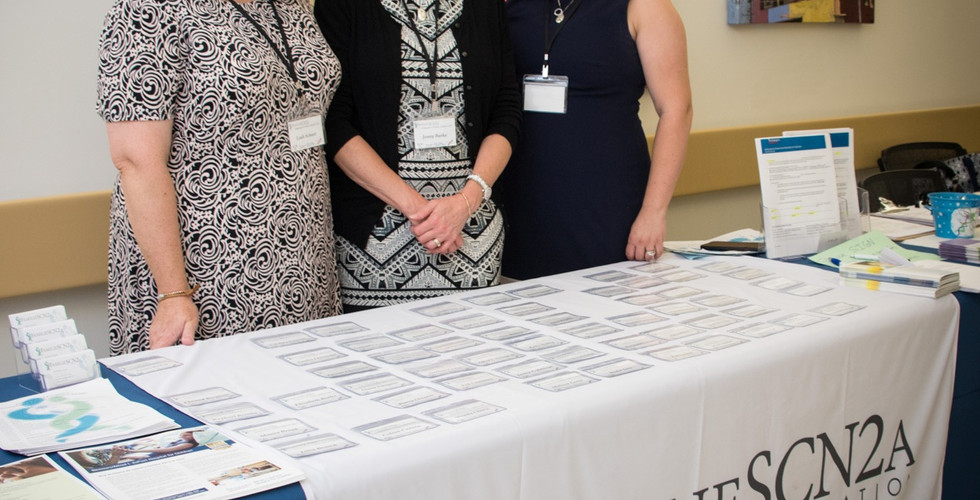Families Provide the Lamp for the Path: Lessons Learned During the 2017 Family & Professional Co
- Angie Auldridge
- Jul 27, 2017
- 4 min read


Perhaps the best way to summarize the highlights from our two days of learning is to provide a bit of a comparison and context of the growth and depth of knowledge that has been learned about the SCN2A genetic mutation in the last year. As one of the scientists stated at the end of the conference, "it's amazing how much this has snow balled."
During last year’s conference in Chicago, families were introduced to the concept of loss of function versus gain of function of the mutations, with presentations demonstrating the differences in the variants, some causing too much sodium released through the channel, and others not enough, giving subtle clues to gain or loss of function. Given the vast difference of presentation among children impacted by the mutation, some having hundreds and thousands of seizures per day and others with no seizures at all, it became clear that there were differences in how each individual variant impacted the sodium channel.
Our community began to wonder if it was as simple as: no seizures = loss of function (not enough sodium being allowed through the channel), and seizures = gain of function (too much sodium being allowed through a faulty channel). However, this year, researchers determined that the age of onset of seizures is more of a determinant of gain versus loss. Those children impacted in the neonate period, so early onset epilepsy, indicated gain of function mutations, and those children with later onset epilepsy showed a loss of function in the channel. So why does this matter? The mechanism in which the mutation can be corrected or mitigated with medication or gene editing will depend on how the channel is operating or not operating in our children’s cases. This is a gross oversimplification of the differences but the main point is that they are determining that the specific genotype (variant) and the resulting phenotype (observable behavior) are leading to greater understanding of the mutations.
A steady component to the conference was the presence and expertise from the wonderful staff at Simons VIP. They were on hand throughout the entire conference to review genetic reports with families, as well as provide information about participating in the database. A common thread to what is needed to propel research forward is a centralized repository of genetic information easily accessible for researchers. We have this with Simons VIP, and their wonderful staff were on hand to educate families on the process of being included.
Most notably, a major difference this year was the inclusion of family stories and presentations. Professionals and families were treated to the unique opportunity to see photos, videos and hear directly from parents about their children affected by SCN2A. Between each of the sessions, children were highlighted, and based on the informal feedback we heard during the conference, researchers were impacted. Their work means something, very specifically to the families sitting among them in the room. This added a human element that brought those that attended together in a very meaningful way.
The conference was concluded with two very important meetings. A professional round table was held to provide the opportunity for collaboration and acceleration of lab work, and prevention of duplicating efforts.
Topics discussed included:
A sodium channelopathy meeting will occur next year with researchers investigating SCN1A, SCN2A, SCN8A and possibly others. This will be by invitation only and not open to families.
Researchers shared their wish lists of the types of data that would be most useful.
The need for electrophysiologists to work together to reduce duplication of efforts was discussed.
A scientific advisory board is a goal for the foundation and brainstorming began regarding who to include.
A white paper will be published by those that contributed to the conference, as well as the workshop meeting held earlier this year.

And families met to learn what the board members of FamilieSCN2A have been up to and receive feedback on the direction in which the foundation can go. During the family meeting, parents and caregivers were given the opportunity to ask questions and suggest ideas for further growth.
Ideas that emerged included:
A one page tool kit that would include important information for newly diagnosed families
A newly diagnosed area of the website for new families
A point of contact in each region of country/world for new families
A one page document for neurologists
A list sent to families outlining how and what families can do to help and use their specific skill sets to assist the efforts of the foundation
A parent break out session at our next conference to share ideas
A sibling break out session was suggested as an add on to our next conference with a facilitator present to work specifically with siblings, which is often referred to as “Sib Shops”
One of the treats of attending the conference is the connection between families and professionals. Similar to last year, during breaks, lunch, and the family and professional dinner, professionals spread out and interacted directly with families regarding their specific children. Access to over forty people invested in treating, providing intervention and researching SCN2A was a unique opportunity for families to consider different care options as well as to educate researchers on what they are seeing at home. This type of organization and collaboration is what makes the difference and propels the process forward. Families are the driving force behind the efforts and this year’s conference exemplified that.
We leave you with a video that aired during the conference showing some of the beautiful faces of children who have a genetic change in the SCN2A gene.

















































Comments